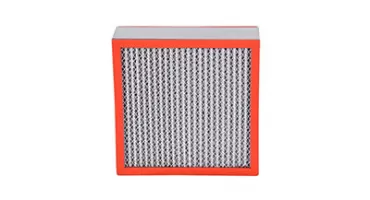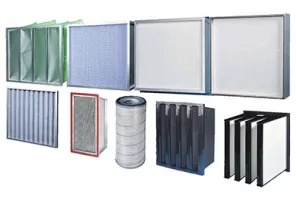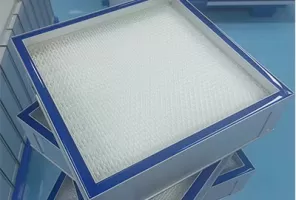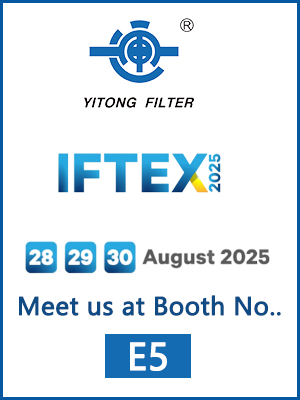 December 07, 2023
December 07, 2023
I. Introduction
A. Definition of HEPA Filters
HEPA, or High-Efficiency Particulate Air filtersare highly specialized devices designed to trap and eliminate airborne particles. These filters are constructed using a dense arrangement of glass fibers or synthetic materials arranged in a mat-like form. Their design enables them to capture and retain a significant amount of microscopic particles that might otherwise circulate in the air.
B. Historical Background
The development of HEPA filters traces back to the 1940s during World War II. These filters were initially created to safeguard scientists and engineers working on the Manhattan Project from radioactive particles. Over time, their use expanded beyond nuclear applications to various industries like healthcare, manufacturing, and residential settings due to their exceptional filtration capabilities.
C. Importance in Air Filtration
HEPA filters play a critical role in maintaining air quality by effectively capturing particles as small as 0.3 microns with an efficiency of 99.97%. This includes common allergens such as pollen, pet dander, mold spores, and even some bacteria and viruses. The significance of HEPA filters in air filtration cannot be overstated, especially in environments where air purity is crucial for health, safety, and the prevention of airborne diseases. Whether in medical facilities, clean rooms, or everyday HVAC systems, HEPA filters are indispensable for maintaining clean and breathable air.
A. Filtration Mechanism
1. Particle Capture Process
HEPA filters employ a sophisticated filtration mechanism that relies on three main processes: interception, impaction, and diffusion. These processes work in unison to trap particles suspended in the air. Interception occurs when particles traveling in the air stream come into contact with the filter fibers, sticking to them as the air passes through. Impaction involves larger particles unable to follow the airflow curve, colliding with the fibers and getting trapped. Diffusion captures the smallest particles that move erratically due to Brownian motion, causing them to collide and adhere to the filter fibers.
2. Size Exclusion Principle
One of the defining characteristics of HEPA filters is their ability to trap particles as small as 0.3 microns with high efficiency. While particles smaller than this size can bypass the filter, the size exclusion principle refers to the filter's optimal performance at capturing particles around the 0.3-micron mark. Despite their size, particles of this dimension exhibit the most resistance to air flow, making them more likely to be captured by the filter media.
B. Components of a HEPA Filter
1. Filter Media
The filter media within a HEPA filter is the heart of its effectiveness. It consists of densely packed fibers made from materials like fiberglass or synthetic polymers. These fibers are arranged in a random pattern to create a maze-like structure that traps particles while allowing air to pass through. The dense arrangement of fibers maximizes the surface area available for particle capture, enhancing the filter's efficiency.
2. Frame and Sealing
Apart from the filter media, the frame and sealing of a HEPA filter are crucial components. The filter is encased in a sturdy frame that holds the media in place and ensures a proper fit within the air handling system. Additionally, effective sealing between the filter and its housing prevents air bypass, ensuring that all the air passes through the filter, and maximizing filtration efficiency. The frame and sealing play a pivotal role in maintaining the integrity of the filter and preventing air leakage, ensuring optimal performance.
III. HEPA Filter Standards and Classifications
A. Particle Size Efficiency
HEPA filters are graded based on their efficiency in capturing particles of varying sizes. The standard efficiency rating of HEPA filters revolves around their ability to capture particles as small as 0.3 microns. However, they are also effective at trapping particles both smaller and larger than this threshold. The efficiency is typically measured in terms of their Minimum Efficiency Reporting Value (MERV) or High-Efficiency Particulate Air (HEPA) ratings, signifying their capability to capture particles of different sizes.
B. Standards and Regulations (e.g., EN1822, ASME AG-1)
Several organizations have established stringent standards and regulations governing the manufacturing and performance of HEPA filters. For instance, the European Committee for Standardization (CEN) has defined standards like EN1822, outlining the requirements and testing methods for HEPA filters used in various applications. The American Society of Mechanical Engineers (ASME) AG-1 code provides guidelines for nuclear facility applications, ensuring HEPA filters meet specific safety and performance criteria in such sensitive environments.
These standards and regulations dictate parameters such as filtration efficiency, airflow resistance, and filter integrity testing procedures, ensuring that HEPA filters meet stringent quality and performance benchmarks across different industries and applications.
C. HEPA Filter Classes (e.g., H10-H14, U.S. DOE Standards)
HEPA filters are categorized into different classes denoted by letters and numbers, each representing varying levels of filtration efficiency. Classes range from H10 to H14, with H14 being the highest grade available. For instance, an H14-class HEPA filter has a minimum efficiency of 99.995% for capturing particles of 0.3 microns in size. Additionally, the U.S. Department of Energy (DOE) has its own standards for HEPA filters, defining specific requirements for filters used in various sectors, particularly in energy-related applications.
These classifications serve as a guide for consumers and industries to select the appropriate HEPA filter based on the desired level of filtration efficiency required for their specific application, ensuring optimal performance and air quality control.
IV. Applications of HEPA Filters
A. Medical Settings
1. Hospitals and Operating Rooms
HEPA filters are indispensable in hospitals and operating rooms where maintaining a sterile environment is critical. These filters are integrated into ventilation systems to remove airborne pathogens and contaminants, reducing the risk of infections during surgeries and providing a clean environment for patient recovery.
2. Laboratories and Clean Rooms
In laboratories, especially those conducting sensitive experiments or research involving biological agents, chemicals, or pharmaceuticals, HEPA filters are vital. Clean rooms, used in industries like microelectronics and biotechnology, rely heavily on HEPA filters to maintain ultra-clean environments by eliminating particles and maintaining stringent air quality standards.
B. Residential and Commercial Use
1. HVAC Systems
HEPA filters are increasingly integrated into HVAC (Heating, Ventilation, and Air Conditioning) systems in both residential and commercial buildings. These filters help improve indoor air quality by trapping dust, pollen, pet dander, and other airborne particles, enhancing the overall health and comfort of occupants.
2. Vacuum Cleaners and Air Purifiers
Vacuum cleaners and standalone air purifiers equipped with HEPA filters have gained popularity in households. These devices efficiently capture allergens and pollutants, providing cleaner air and reducing allergic reactions in homes.
C. Industrial Applications
1. Aerospace and Pharmaceutical Industries
In aerospace and pharmaceutical manufacturing, where maintaining sterile environments is crucial, HEPA filters are used extensively. They help ensure that the production areas remain free from contaminants that could compromise the quality of sensitive equipment or products.
2. Nuclear and Semiconductor Facilities
In nuclear facilities, HEPA filters are employed to control airborne radioactive particles, providing a critical barrier against contamination. Similarly, semiconductor manufacturing facilities utilize HEPA filters to maintain clean environments necessary for producing microchips and electronic components free from dust and contaminants.
These applications illustrate the versatility and significance of HEPA filters across various industries and settings, where maintaining high air quality and reducing the risk of contamination are paramount.
V. Benefits and Limitations
A. Advantages of HEPA Filters
1. High-Efficiency Filtration
One of the foremost advantages of HEPA filters is their exceptional efficiency in capturing particles as small as 0.3 microns with an efficiency of 99.97%. This high filtration efficiency makes them instrumental in removing a wide range of pollutants, including dust, pollen, bacteria, and some viruses, from the air.
2. Removal of Allergens and Harmful Particles
HEPA filters are highly effective in removing allergens and harmful airborne particles, making them invaluable for individuals prone to allergies or respiratory issues. By reducing the presence of allergens like pet dander, mold spores, and dust mites, HEPA filters contribute significantly to improving indoor air quality and overall health.
B. Limitations and Considerations
1. Maintenance and Replacement
Regular maintenance and timely replacement of HEPA filters are essential for optimal performance. Over time, as the filter captures particles, its efficiency may decrease, potentially affecting air quality. Consequently, scheduled maintenance and replacing filters as recommended by manufacturers are necessary to ensure continued effectiveness.
2. Size and Space Constraints
HEPA filters can be bulky, especially in larger systems or applications requiring substantial air filtration. Their size and space requirements might pose challenges when integrating them into certain devices or spaces, necessitating careful planning and accommodations to accommodate these filters effectively.
Understanding these advantages and limitations is crucial when considering the implementation of HEPA filters. While they offer unparalleled filtration efficiency and air quality improvement, ensuring proper maintenance and addressing space limitations are key considerations for maximizing their benefits.
VI. Conclusion
A. Recap of HEPA Filter Significance
In summary, HEPA filters have revolutionized air filtration by providing an unparalleled level of efficiency in capturing airborne particles as small as 0.3 microns. Their significance spans across various industries and settings, serving as a cornerstone for maintaining clean and healthy environments. From medical facilities to residential spaces and industrial applications, HEPA filters play a pivotal role in enhancing air quality and mitigating health risks associated with airborne contaminants.
B. Future Outlook and Potential Developments
Looking ahead, the future of HEPA filters appears promising with ongoing advancements and potential developments. Innovations in materials, such as the integration of nanotechnology, are likely to enhance filter performance and efficiency. Moreover, the emergence of smart filtering systems equipped with sensors and adaptive technologies holds promise for more efficient and responsive air purification solutions.
C. Final Thoughts on HEPA Filter Evolution and Influence
The evolution of HEPA filters from their origins in specialized applications to their widespread use in various sectors underscores their influence on air quality standards and health advancements. As these filters continue to evolve, their impact on creating cleaner and safer environments will persist, contributing significantly to human health and well-being.
In conclusion, the evolution, significance, and future potential of HEPA filters reflect their indispensable role in improving air quality and shaping the way we safeguard against airborne pollutants and contaminants. Their continued development and integration into diverse applications reaffirm their status as a cornerstone of modern air filtration technology.
 Jun. 28, 2023
Purpose and Characteristics of High-Temperature Air Filters
Jun. 28, 2023
Purpose and Characteristics of High-Temperature Air Filters
 Sep. 11, 2024
The Role of HEPA Filters in HVAC Systems: A Comprehensive Guide
Sep. 11, 2024
The Role of HEPA Filters in HVAC Systems: A Comprehensive Guide
 Aug. 27, 2024
Air Filtration in Cleanrooms
Aug. 27, 2024
Air Filtration in Cleanrooms

